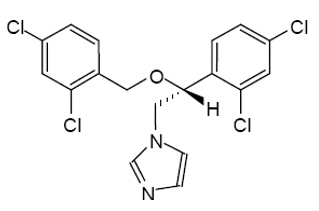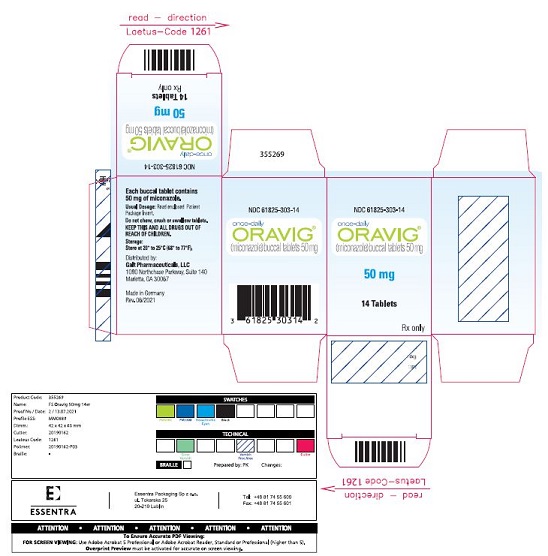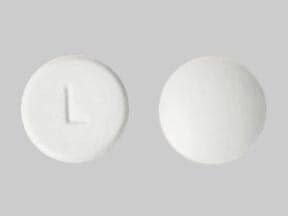Oravig
Generic name: miconazole oral (buccal)
Drug class: Azole antifungals
Medically reviewed by A Ras MD.
What is Oravig used for?
Oravig is a prescription medicine that is used to treat fungal infections in the mouth.
Description
ORAVIG (miconazole) buccal tablets are applied topically to the gum once daily and release miconazole as the buccal tablet gradually dissolves .
Miconazole is an imidazole antifungal agent and is described chemically as 1-[(2RS)-2-[(2,4-dichlorobenzyl)oxy]-2-(2,4-dichlorophenyl)ethyl]-1H-imidazole with an empirical formula of C 18H 14Cl 4N 2O and a molecular weight of 416.13. The structural formula is shown in Figure 1.
Figure 1: Structural Formula of Miconazole

Miconazole drug substance is a white to almost white powder.
ORAVIG contains 50 mg of miconazole base, USP and the following inactive ingredients: hypromellose, USP; milk protein concentrate; corn starch, NF; lactose monohydrate, NF; sodium lauryl sulfate, NF; magnesium stearate, NF; and talc, USP.
Before taking Oravig, tell your doctor:
For all patients taking Oravig:
- If you are allergic to Oravig; any part of this medicine; or any other drugs, foods, or substances. Tell your doctor about the allergy and what signs you had.
- If you have a milk allergy.
Children:
- If the patient is a young child. Do not give Oravig to a young child. Talk with the doctor.
This medicine may interact with other drugs or health problems.
Tell your doctor and pharmacist about all of your drugs (prescription or OTC, natural products, vitamins) and health problems. You must check to make sure that it is safe for you to take Oravig with all of your drugs and health problems. Do not start, stop, or change the dose of any drug without checking with your doctor.
What are some things I need to know or do while I take Oravig?
- Tell all of your health care providers that you take Oravig. This includes your doctors, nurses, pharmacists, and dentists.
- Tell your doctor if you are pregnant, plan on getting pregnant, or are breast-feeding. You will need to talk about the benefits and risks to you and the baby.
How is Oravig best taken?
Use Oravig as ordered by your doctor. Read all information given to you. Follow all instructions closely.
- Use as you have been told, even if your signs get better.
- Use in the morning after brushing teeth.
- Wash your hands before and after use.
- Dry your hands and place the tablet in your mouth above the incisor tooth between the upper cheek and gum. Leave the tablet in place until it dissolves.
- Use your finger to put slight pressure on the outside of the upper lip to make the tablet stick to the gum. Hold the tablet in place for 30 seconds.
- Switch sides of your mouth each day when you place Oravig.
- Do not swallow whole. Do not chew, break, or crush.
- Either side of tablet may be placed next to the gum, but the rounded side may feel better.
- You may eat and drink when using Oravig. Avoid doing things that may knock the tablet loose like chewing gum, touching the tablet, wearing upper dentures, and brushing your teeth.
- If the tablet does not stick to the gum or falls out within 6 hours, put the tablet back in.
- If you swallow the tablet within 6 hours, drink a glass of water and use a new tablet.
- If the tablet falls out or is swallowed after 6 hours, do not put back in until the next dose.
What do I do if I miss a dose?
- Use a missed dose as soon as you think about it.
- If it is close to the time for your next dose, skip the missed dose and go back to your normal time.
- Do not use 2 doses at the same time or extra doses.
What are the side effects of Oravig that I need to call my doctor about immediately?
WARNING/CAUTION: Even though it may be rare, some people may have very bad and sometimes deadly side effects when taking a drug. Tell your doctor or get medical help right away if you have any of the following signs or symptoms that may be related to a very bad side effect:
- Signs of an allergic reaction, like rash; hives; itching; red, swollen, blistered, or peeling skin with or without fever; wheezing; tightness in the chest or throat; trouble breathing, swallowing, or talking; unusual hoarseness; or swelling of the mouth, face, lips, tongue, or throat.
- Pain where it was placed.
- Swelling where Oravig is used.
What are some other side effects of Oravig?
All drugs may cause side effects. However, many people have no side effects or only have minor side effects. Call your doctor or get medical help if any of these side effects or any other side effects bother you or do not go away:
- Headache.
- Upset stomach or throwing up.
- Stomach pain or diarrhea.
- Change in taste.
These are not all of the side effects that may occur. If you have questions about side effects, call your doctor. Call your doctor for medical advice about side effects.
You may report side effects to the FDA at 1-800-332-1088. You may also report side effects at https://www.fda.gov/medwatch.
If overdose is suspected:
If you think there has been an overdose, call your poison control center or get medical care right away. Be ready to tell or show what was taken, how much, and when it happened.
How do I store and/or throw out Oravig?
- Store at room temperature.
- Store in a dry place. Do not store in a bathroom.
- Keep all drugs in a safe place. Keep all drugs out of the reach of children and pets.
- Throw away unused or expired drugs. Do not flush down a toilet or pour down a drain unless you are told to do so. Check with your pharmacist if you have questions about the best way to throw out drugs. There may be drug take-back programs in your area.
Label
PACKAGE LABEL.PRINCIPAL DISPLAY PANEL
- NDC 61825-303-14
- once-daily
ORAVIG® (miconazole) buccal tablets 50 mg - 50 mg
- 14 Tablets
- Rx only


SRC: NLM .
